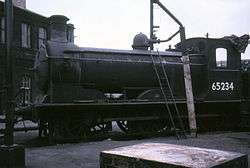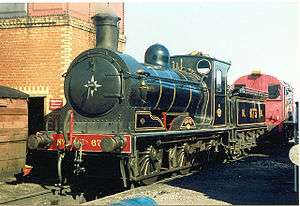NBR C Class
|
Preserved 673 Maude in NBR livery. She represented Scotland at the Rainhill Trials 150th anniversary cavalcade in May 1980, hauling a Caledonian Railway coach. | |||||||||||||||||||||||||||
| |||||||||||||||||||||||||||
| |||||||||||||||||||||||||||
| |||||||||||||||||||||||||||
| |||||||||||||||||||||||||||
The NBR C Class (LNER Class J36) is a class of 0-6-0 steam locomotive designed by Matthew Holmes for freight work on the North British Railway. They were introduced in 1888 and had inside cylinders and Stephenson valve gear. A total of 168 locomotives was built, of which 123 came into British Railways ownership at nationalisation in 1948. This was the last class of steam engine in service in Scotland.
The NBR C Class (LNER Class J32) is a class of 0-6-0 steam locomotive designed by Dugald Drummond for freight work on the North British Railway. They were built in 1876 and 1877 and had large 18" cylinders. A total of 32 locomotives was built. The NBR gave these engines the same designation (C class) as the Matthew Holmes engines above. The two types were very similar, and shared the same (then unusual) 18" cylinder size. Between 1898 and 1903 Matthew Holmes had all 32 of the Drummond locomotives rebuilt to match his own C class design. Thus the locomotives were considered a single class by the NBR, although on passing to LNER ownership they received the separate designations of J36 and J32 respectively.
Technical information
As built they had a saturated (non-superheated) boiler at 140 lbf/in2 or 0.97 MPa (150 lbf/in2 or 1.03 MPa for the last 24)[2] and Stephenson valve gear with slide valves. Between 1913 and 1923 the class was rebuilt with bigger boilers set at 165 psi and the Reid side-window cab.
Ownership
NBR
- Predecessors
After the introduction of the Drummond Class C (LNER Class J32) 18-inch (cylinder diameter) 0-6-0s, essentially for the Waverley Route in 1876, the NBR reverted to the 17-inch design with the Drummond Class D (J34) in 1879 and the Holmes Class D (J33) in 1883.
- The Holmes Class C
With the opening of the second Tay Bridge in July 1887 and the upcoming opening of the Forth Bridge in March 1890 the NBR needed more powerful goods locos. The result was the Holmes Class C (J36). Introduced in 1888 it was built in regular batches until 1900, eventually totalling 168 locos. 138 were built at the NBR's Cowlairs Works while the other 30 were split equally between Neilson and Company and Sharp, Stewart and Company.
- World War I
During the First World War 25 of the class were sent to France for service with the Railway Operating Division. On return to Scotland they were given names of battles, generals and a cartoon soldier in recognition of their service. The names were hand-painted on the splasher above the middle driving wheel so often disappeared during repaints.
LNER
On 1 January 1923 all 168 locos passed into the hands of the LNER and became Class J36. As with all ex-NBR locos they had 9000 added to their number. The final 8 unrebuilt locos were rebuilt in 1923. In 1937 locomotives 9714 and 9716 (later 5285 and 5287)[3] were rebuilt with cutdown chimney and dome for use on the Gartverrie Branch. In 1946 the remaining locos were renumbered from 5210 to 5346. A number of locos had tender cabs fitted for use with snow ploughs.
BR

On 1 January 1948 at nationalisation, 123 locos passed into the hands of British Railways and had 60000 added to their number. On 5 June 1967 65288 of Dunfermline (62C) and 65345 of Thornton (62A) were withdrawn. They were the last steam locomotives in service in Scotland.
Locomotive names
| NBR Number |
LNER 1946 Number | BR Number | Name |
|---|---|---|---|
| 176 | 5217 | 65217 | French |
| 605 | St Quentin | ||
| 608 | Foch | ||
| 611 | 5268 | 65268 | Allenby |
| 612 | 5269 | Ypres | |
| 615 | Verdun | ||
| 620 | Rawlinson | ||
| 621 | Monro | ||
| 627 | Petain | ||
| 628 | 5216 | 65216 | Byng |
| 631 | Aisne | ||
| 643 | Arras | ||
| 646 | 5222 | 65222 | Somme |
| 647 | 5223 | Albert | |
| 648 | 5224 | 65224 | Mons |
| 650 | 5226 | 65226 | Haig |
| 657 | 5233 | 65233 | Plumer |
| 659 | 5235 | 65235 | Gough |
| 660 | 5236 | 65236 | Horne |
| 661 | Ole Bill | ||
| 662 | Birdwood | ||
| 666 | Marne | ||
| 673 | 5243 | 65243 | Maude |
| 676 | Reims | ||
| 682 | 5253 | 65253 | Joffre |
Preservation
One, 673 Maude (LNER number 9673; LNER 1946 number 5243; BR number 65243) has been preserved by the Scottish Railway Preservation Society at the Bo'ness and Kinneil Railway. It starred in the 2000 remake of The Railway Children on the Bluebell Railway in East Sussex.
Trivia
65288 was adopted by Dunfermline High School Railway Society and was repainted by society members while still in BR service . It was fitted with one small and one normal sized buffer at the front end.
References
- ↑ Fry 1966, p. 215.
- ↑ Marsden, Richard. "The Holmes J36 (NBR Class C) 0-6-0 Locomotives". LNER encyclopedia.
- ↑ http://www.nbrstudygroup.co.uk/nbr/locomotives_list.htm
- Ian Allan ABC of British Railways Locomotives, 1962 edition
- Aves, William A. T. (2009). The Railway Operating Division on the Western Front. Donnington: Shaun Tyas. pp. 147, 159. ISBN 978-1-900289-99-3.
- Casserley, H.C. & Johnston, Stuart W. (1974) [1966]. Locomotives at the Grouping 2: London & North Eastern Railway. Shepperton, Surrey: Ian Allan Limited. p. 56. ISBN 0-7110-0553-2.
- Fry, E.V., ed. (September 1966). Locomotives of the L.N.E.R., part 5: Tender Engines - Classes J1 to J37. Kenilworth: RCTS. ISBN 0-901115-12-6.
External links
| Wikimedia Commons has media related to NBR C Class / LNER Class J36. |
- Railuk database entry for J36
- Scottish Railway Preservation Society page on Maude
- Preserved locomotive database entry for Maude
- NBR/LNER Holmes "J36" Class 0-6-0 at BRDatabase
